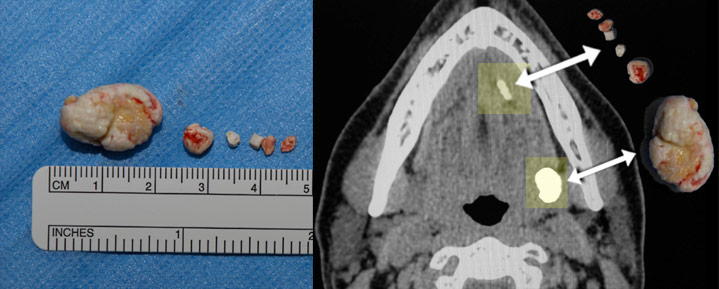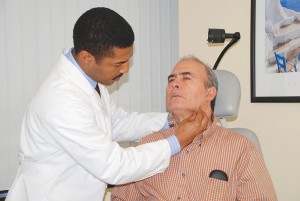- India Medical Mission 2018 - November 1, 2018
- Sleep Disorders: Sleep Apnea and Upper Stimulation Therapy - August 25, 2015
- The Naked Vocalist Podcast Featuring Dr. Reena Gupta - May 27, 2015
- New Therapy for Sleep Apnea – First Sleep Pacemaker placed in California at Osborne Head and Neck Institute. - December 12, 2014
- Boxer’s Ear: Can your ear explode? - December 12, 2014
- Nose Picking (Rhinotillexis) and Septal Perforations: Why I should stop picking my nose…? - November 24, 2014
- Deviated Septum and Septal Perforation - July 28, 2014
- Hereditary Hemorrhagic Telangiectasia: Nasal Septal Perforation Repair - June 25, 2014
- Dr. Mantle recognized at the Beverly Hills Medical Science Academy Awards - May 8, 2014
- Commonly Misdiagnosed Pathologies: Arteriovenous Malformations - April 9, 2014
Can large salivary gland stones be removed without surgery?
Question: A few weeks ago I started to have pain and swelling along my lower jaw during eating. I also noticed that my mouth was drier than usual. I went to my doctor and he said that I most likely had a salivary gland issue. I was referred to an ENT who diagnosed me with salivary gland stones and told me that they were too large to be removed. The ENT mentioned that I would need to have surgery to remove the gland entirely. I have asked for a second and even third opinion but every doctor has told me the same thing. I am apprehensive about this decision because I would rather avoid the complications of surgery, if possible. Are there any methods available to remove large salivary gland stones non-surgically?
Answer:
Yes, most salivary gland stones (sialolithiasis) can now be treated without surgical intervention. Sialendoscopy is a modern and minimally invasive procedure for the removal of salivary gland stones of all sizes. This cutting edge technique utilizes very small endoscopes that are passed through the salivary gland’s natural opening in the mouth. These endoscopes allow the physician to visualize the inside of the gland’s ducts while simultaneously diagnosing and treating sialolithiasis and any associated changes to the ductal architecture. These advanced maneuvers are accomplished through the use of small instrumentation that is passed through the endoscope, while avoiding the delicate nerves and vasculature associated with the salivary gland. Due to its high efficacy, low associated complications, and preservation of normal salivation, sialendoscopy is considered the gold standard for management of salivary gland stones.

Currently, traditional surgery, with partial or complete salivary gland excision to remove salivary stones, has lost favor with many physicians and patients alike. The risk of facial nerve paralysis, taste disturbance, facial defects, and an undesirable cosmetic appearance outweigh the benefits of traditional surgery.
Dr. Ryan Osborne, director of Head and Neck Surgery at the Osborne Head and Neck Institute has pioneered the use of sialendoscopy for the treatment of persistent salivary gland stones. Dr. Osborne has recognized that patients with a suspected or confirmed diagnosis of sialolithiasis can benefit from the diagnostic and therapeutic aspects of a single procedure while avoiding the potential complications of classic surgical interventions.
For more information on sialendoscopy and the removal of persistent salivary gland stones, please contact the Osborne Head and Neck Institute.
Key Points:
- Most salivary glands can be treated without traditional surgical interventions.
- Sialendoscopy is a modern and minimally invasive procedure for the removal of salivary gland stones of all sizes.
- Small endoscopes are passed through the salivary glands natural opening in the mouth, allowing a physician to diagnose and treat persistent stones.
- Due to its high efficacy and lack of serious complications, sialendoscopy is considered the gold standard treatment for salivary gland stones.
- Dr. Ryan Osborne, director of Head and Neck Surgery at the Osborne Head and Neck Institute has pioneered the use of sialendoscopy for the treatment of persistent salivary gland stones.



